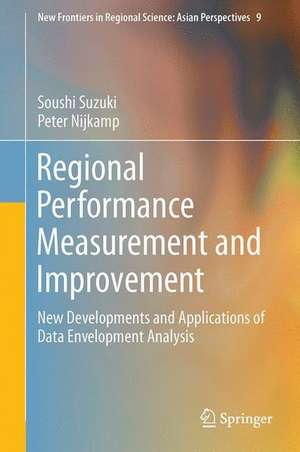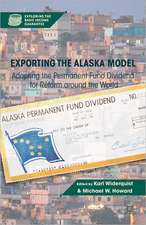Regional Performance Measurement and Improvement: New Developments and Applications of Data Envelopment Analysis: New Frontiers in Regional Science: Asian Perspectives, cartea 9
Autor Soushi Suzuki, Peter Nijkampen Limba Engleză Hardback – 24 mar 2017
This is the first book to fully introduce a newly developed distance friction minimization (DFM) model, which is one of the new efficiency improvement projection approaches in data envelopment analysis (DEA). The DFM model can produce a most effective solution in efficiency improvement projections for inefficient spatial entities (decision-making units).
The book provides a set of fresh contributions to a quantitative assessment of the performance of such policy entities. First it offers a state-of-the art overview of current DEA models and approaches, followed by the operational design of various new types of DEA models, each of them addressing weaknesses in traditional DEA approaches. Then it illustrates the assessment potential of DEA — and its new variants, in particular, the DFM model and subsequent extensions — on the basis of a broadly composed collection of empirical case studies, centering mainly but not exclusively on Japan and other Asian nations.
| Toate formatele și edițiile | Preț | Express |
|---|---|---|
| Paperback (1) | 574.33 lei 38-44 zile | |
| Springer Nature Singapore – 25 iul 2018 | 574.33 lei 38-44 zile | |
| Hardback (1) | 699.45 lei 3-5 săpt. | |
| Springer Nature Singapore – 24 mar 2017 | 699.45 lei 3-5 săpt. |
Din seria New Frontiers in Regional Science: Asian Perspectives
- 15%
 Preț: 652.64 lei
Preț: 652.64 lei - 18%
 Preț: 742.00 lei
Preț: 742.00 lei - 15%
 Preț: 645.96 lei
Preț: 645.96 lei - 18%
 Preț: 798.18 lei
Preț: 798.18 lei - 18%
 Preț: 728.74 lei
Preț: 728.74 lei - 18%
 Preț: 724.14 lei
Preț: 724.14 lei - 18%
 Preț: 733.33 lei
Preț: 733.33 lei - 15%
 Preț: 693.25 lei
Preț: 693.25 lei - 15%
 Preț: 640.06 lei
Preț: 640.06 lei - 15%
 Preț: 702.87 lei
Preț: 702.87 lei - 15%
 Preț: 718.61 lei
Preț: 718.61 lei - 18%
 Preț: 786.36 lei
Preț: 786.36 lei - 18%
 Preț: 1110.72 lei
Preț: 1110.72 lei - 15%
 Preț: 644.18 lei
Preț: 644.18 lei - 18%
 Preț: 787.78 lei
Preț: 787.78 lei - 18%
 Preț: 897.47 lei
Preț: 897.47 lei - 15%
 Preț: 643.34 lei
Preț: 643.34 lei -
 Preț: 395.25 lei
Preț: 395.25 lei - 18%
 Preț: 892.42 lei
Preț: 892.42 lei -
 Preț: 386.39 lei
Preț: 386.39 lei - 24%
 Preț: 594.43 lei
Preț: 594.43 lei - 18%
 Preț: 900.31 lei
Preț: 900.31 lei - 15%
 Preț: 714.02 lei
Preț: 714.02 lei - 15%
 Preț: 698.62 lei
Preț: 698.62 lei - 24%
 Preț: 632.82 lei
Preț: 632.82 lei - 18%
 Preț: 1244.59 lei
Preț: 1244.59 lei - 15%
 Preț: 644.63 lei
Preț: 644.63 lei - 18%
 Preț: 785.42 lei
Preț: 785.42 lei - 15%
 Preț: 639.73 lei
Preț: 639.73 lei -
 Preț: 357.81 lei
Preț: 357.81 lei - 18%
 Preț: 1111.53 lei
Preț: 1111.53 lei - 18%
 Preț: 721.33 lei
Preț: 721.33 lei
Preț: 699.45 lei
Preț vechi: 822.87 lei
-15% Nou
Puncte Express: 1049
Preț estimativ în valută:
133.86€ • 145.35$ • 112.44£
133.86€ • 145.35$ • 112.44£
Carte disponibilă
Livrare economică 01-15 aprilie
Preluare comenzi: 021 569.72.76
Specificații
ISBN-13: 9789811002410
ISBN-10: 981100241X
Pagini: 210
Ilustrații: XII, 185 p. 88 illus., 62 illus. in color.
Dimensiuni: 155 x 235 x 17 mm
Greutate: 0.49 kg
Ediția:1st ed. 2017
Editura: Springer Nature Singapore
Colecția Springer
Seria New Frontiers in Regional Science: Asian Perspectives
Locul publicării:Singapore, Singapore
ISBN-10: 981100241X
Pagini: 210
Ilustrații: XII, 185 p. 88 illus., 62 illus. in color.
Dimensiuni: 155 x 235 x 17 mm
Greutate: 0.49 kg
Ediția:1st ed. 2017
Editura: Springer Nature Singapore
Colecția Springer
Seria New Frontiers in Regional Science: Asian Perspectives
Locul publicării:Singapore, Singapore
Cuprins
Part 1: Model.- 1. Introduction.- 2. Overview of the Data Envelopment Analysis (DEA) and Improvement Projection.- 3. Data Envelopment Analysis (DEA) for Performance Measurement and Improvement.- 4. Distance Friction Minimization (DFM) Model.- 5. Advanced DFM Models.- 6. Matrix of DFM Model.- Part 2: Applications.- 7. Performance Measurement of Local Government Finance in Japan: Combination of Goal-Achievement Model with CCR Model.- 8. Performance Measurement of Public Transport Operation in Japan: Combination of Stepwise Model with CCR Model.- 9. Performance Measurement of Asian City: Combination of Stepwise Model with SE Model.- 10. Energy-Environment Performance after Fukushima Problem in Japan: Combination of Target-Oriented Model with SE Model.- 11. New Energy Performance in Japan: Combination of Improvement Adjustment Model with CCR Model.- 12. Performance Measurement of Energy-Environment-Economic for EU, APEC and ASEAN Countries: Combination of Fixed Factor Model with SuperEfficiency Model.- 13.Performance Measurement of Airport Operation in Japan: Combination of Stepwise Model with Fixed Factor Model.
Notă biografică
Soushi Suzuki, Professor Dr., Hokkai-Gakuen University, soushi-s@lst.hokkai-s-u.ac.jp, Department of Life Science and Technology, Hokkai-Gakuen University, 1-1 South 26 West 11, Chuo-ku, 0640926, Sapporo, Japan
Peter Nijkamp, Professor Dr., VU University Amsterdam, p.nijkamp@vu.nl, Department of Spatial Economics, VU University Amsterdam, De Boelelaan 1105, 1081HV, Amsterdam, The Netherlands
Textul de pe ultima copertă
This is the first book to fully introduce a newly developed distance friction minimization (DFM) model, which is one of the new efficiency improvement projection approaches in data envelopment analysis (DEA). The DFM model can produce a most effective solution in efficiency improvement projections for inefficient spatial entities (decision-making units).
The book provides a set of fresh contributions to a quantitative assessment of the performance of such policy entities. First it offers a state-of-the art overview of current DEA models and approaches, followed by the operational design of various new types of DEA models, each of them addressing weaknesses in traditional DEA approaches. Then it illustrates the assessment potential of DEA and its new variants, in particular, the DFM model and subsequent extensions on the basis of a broadly composed collection of empirical case studies, centering mainlybut not exclusively on Japan and other Asian nations.
Caracteristici
Facilitates an in-depth understanding of regional performance measurement and improvement based on data envelopment analysis Provides a detailed explanation of a new efficiency improvement approach, the distance friction minimization model Furnishes through these new models an effective efficiency-enhancing approach for inefficient regional decision-making units in Japan and other parts of Asia















